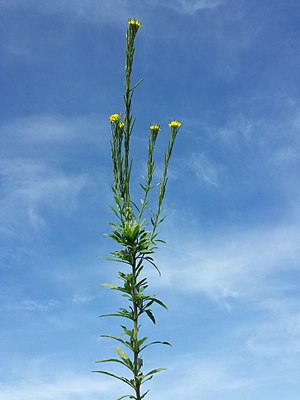Rod Schöterich
| Rod Schöterich | ||||||||||||
|---|---|---|---|---|---|---|---|---|---|---|---|---|

Tailed Scotch ( Erysimum hieraciifolium ) |
||||||||||||
| Systematics | ||||||||||||
|
||||||||||||
| Scientific name | ||||||||||||
| Erysimum hieraciifolium | ||||||||||||
| L. |
The Rod Schöterich ( Erysimum hieraciifolium , Syn .: Erysimum virgatum Roth ) - also Stiff Schöterich - is a species of the cruciferous family (Brassicaceae).
description
The Ruten-Schöterich is a biennial to perennial herbaceous plant that usually reaches heights of between 15 and 125 centimeters. On the sharp-edged stalk are elongated, lanceolate leaves that are notched along the entire edge or at a distance. The lower ones are serrated. The leaves are about five to six times as long as they are wide. The hair consists mainly of three-strand star hair. There are also few two, four or five-pointed hairs.
The hermaphrodite flowers are fourfold. The four green sepals are five to eight millimeters long and one to 1.5 mm wide. The four large, golden-yellow petals covered with star hair are usually seven to nine (six to ten) mm long and 2 to 3 mm wide. In the six fertile stamens , the yellow stamens are 4 to 6 mm long and the anthers 1.5 to 2 mm long. The flowering period of the rods schöterich extends mainly from June to August.
The fruit stalks stand upright on the stem with which they form an angle of about 30 degrees. The four-winged pods are usually 15 to 25 (10 to 55) mm long and 1 to 1.3 mm wide. The seeds have a size of 1 to 1.5 × 0.4 to 0.6 mm.
He has the chromosome number of 2n = 48.
Locations and distribution
The rod schöterich grows in river-accompanying weed communities, debris weed communities and steppe lawns. It prefers nutrient-rich, mostly calcareous stone and sandy soils. It thrives in the societies of the Aegopodion and Alliarion associations.
This species occurs throughout Europe and Asia. In Germany you can find the Rod Schöterich scattered around larger rivers such as the Rhine, Main and Sieg. In Austria and Switzerland this species occurs rather rarely in the colline to alpine area.
Possible confusion
The rod schotterich is quite rich in shape. In the past, a distinction was also made between subspecies, some of which were treated as a separate species (→ Erysimum virgatum ). There is also the possibility of confusion with the very similar-looking hard scotland ( Erysimum marschallianum ), whose pods stick out from the stem at an angle of no more than 10 °. Is very similar and the bleach Wallflower ( Erysimum crepidifolium ), whose leaves are occupied but mainly (compass needle shaped) with two-part hair.
literature
- Henning Haeupler , Thomas Muer: picture atlas of the fern and flowering plants of Germany (= the fern and flowering plants of Germany. Volume 2). Published by the Federal Agency for Nature Conservation. Ulmer, Stuttgart 2000, ISBN 3-8001-3364-4 .
- Wolfgang Adler, Karl Oswald, Raimund Fischer: Excursion flora of Austria. Ed .: Manfred A. Fischer . Ulmer, Stuttgart / Vienna 1994, ISBN 3-8001-3461-6 .
- August Binz , Christian Heitz: School and excursion flora for Switzerland . Schwabe & Co. AG, Basel 1986. ISBN 3-7965-0832-4 .
- Erich Oberdorfer : Plant-sociological excursion flora . Ulmer Verlag, Stuttgart 1990. ISBN 3-8001-3454-3 .
- Christian August Friedrich Garcke : Illustrated flora . Paul Parey Publishing House, Berlin and Hamburg 1972. ISBN 3-489-68034-0 .
Individual evidence
- ↑ a b Erich Oberdorfer : Plant-sociological excursion flora for Germany and neighboring areas . With the collaboration of Angelika Schwabe and Theo Müller. 8th, heavily revised and expanded edition. Eugen Ulmer, Stuttgart (Hohenheim) 2001, ISBN 3-8001-3131-5 , pp. 472-473 .
Web links
- Rod Schöterich. In: FloraWeb.de.
- Distribution map for Germany. In: Floraweb .
- Thomas Meyer: Data sheet with identification key and photos at Flora-de: Flora von Deutschland (old name of the website: Flowers in Swabia )
- Description in the Flora of China (English)







